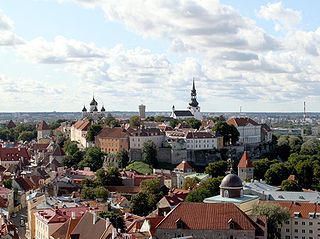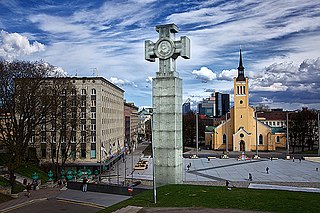
Tallinn is the capital and most populous city of Estonia. Situated on a bay in north Estonia, on the shore of the Gulf of Finland of the Baltic Sea, Tallinn has a population of about 454,000 and administratively lies in the Harju maakond (county). Tallinn is the main financial, industrial, and cultural centre of Estonia. It is located 187 km (116 mi) northwest of the country's second largest city, Tartu, however only 80 km (50 mi) south of Helsinki, Finland, also 320 km (200 mi) west of Saint Petersburg, Russia, 300 km (190 mi) north of Riga, Latvia, and 380 km (240 mi) east of Stockholm, Sweden. From the 13th century until the first half of the 20th century, Tallinn was known in most of the world by variants of its other historical name Reval.

Tartu is the second largest city in Estonia after Tallinn. Tartu has a population of 97,435. It is 186 kilometres southeast of Tallinn and 245 kilometres northeast of Riga, Latvia. Tartu lies on the Emajõgi river, which connects the two largest lakes in Estonia, Lake Võrtsjärv and Lake Peipus. From the 13th century until the end of the 19th century, Tartu was known in most of the world by variants of its historical name Dorpat.

Narva is a municipality and city in Estonia. It is located in the Ida-Viru County, at the eastern extreme point of Estonia, on the west bank of the Narva river which forms the Estonia–Russia international border. With 53,626 inhabitants Narva is Estonia's third largest city after capital Tallinn and Tartu.

Pikk Hermann or Tall Hermann is a tower of the Toompea Castle, on Toompea hill in Tallinn, the capital of Estonia. The first part was built 1360–70. It was rebuilt in the 16th century. A staircase with 215 steps leads to the top of the tower. The tower consists of ten internal floors and a viewing platform at the top.

Toompea is a limestone hill in the central part of the city of Tallinn, the capital of Estonia. The hill is an oblong tableland, which measures about 400 by 250 metres, has an area of 7 hectares and is about 20–30 metres higher than the surrounding areas. In folklore the hill is known as the tumulus mound over the grave of Kalev, erected in his memory by his grieving wife.

Harju County, is one of the fifteen counties of Estonia. It is situated in Northern Estonia, on the southern coast of the Gulf of Finland, and borders Lääne-Viru County to the east, Järva County to the southeast, Rapla County to the south, and Lääne County to the southwest. The capital and largest city of Estonia, Tallinn, is situated in Harju County. Harju County is the largest county in Estonia in terms of population, as almost half (45%) of the Estonia's population lives in Harju County.

AS Kalev is an Estonian confectionery company. The company traces its origins back two hundred years, the business that preceded the Maiasmokk café was founded in 1806, and is now owned by Kalev. The Kalev company is the country's largest producer of sweets and a part of the industrial conglomerate Orkla Group. Kalev is based in Põrguvälja near Jüri, Rae Parish, Harju County.

Rakvere is a town in northern Estonia and the administrative centre of the Lääne-Viru maakond (county), 20 km south of the Gulf of Finland of the Baltic Sea. Rakvere is the 8th most populous urban area in Estonia. Rakvere has a total area of 10.75 square kilometres, and although about 15% of Rakvere is covered by forest, it is still the country's third most densely populated urban area. From the 13th century until the early 20th century, Rakvere was more widely known by its historical German name, Wesenberg(h).

Toompea castle is a medieval castle on Toompea hill in the central part of Tallinn, the capital of Estonia. In modern times, it houses the Parliament of Estonia.

Kiek in de Kök is an artillery tower in Tallinn, Estonia, built in 1475. It gained the name Kiek in de Kök from the ability of tower occupants to see into kitchens of nearby houses. The tower is 38 m high and has walls 4 m thick. Cannon balls dating back to 1577 are still embedded in its outer walls.

Kalamaja is a subdistrict of the district of Põhja-Tallinn in Tallinn, the capital of Estonia. It is located just northwest of the historical town centre, on the coast of the Tallinn Bay. Kalamaja has a population of 9,820.

St. Nicholas Church is a medieval church building in Tallinn (Reval), Estonia. It was dedicated to Saint Nicholas, the patron of the fishermen and sailors. Originally built in the 13th century, it was partially destroyed in the Soviet bombing of Tallinn in World War II. The building itself has since been restored; however, as a church without own congregation, it has not been used for regular religious activities since World War II. At present it houses the Niguliste Museum, a branch of the Art Museum of Estonia, focusing mainly on ecclesiastical art from the Middle Ages onward. It is also used as a concert hall.

EMLKalev (M414) was a Frauenlob-class minesweeper of the Estonian Navy, which belonged to the Mineships Division.

The Estonian Maritime Museum is located in the Fat Margaret tower in the old town of Tallinn. The museum presents the history of ships and navigation in Estonia and related to Estonia. Other parts of the Maritime Museum are the mine museum and the Seaplane Harbour museum where ships are presented. The museum claims to be one of the largest museums in Estonia and the most popular.

Freedom Square is a plaza on the southern end of the Old Town in Tallinn, Estonia, where state functions and various concerts take place. It is bounded on the east by St. John's Church, on the south by Kaarli Boulevard and an underground shopping center (2008–09), and on the west by a Victory Column (2009) commemorating the Estonian War of Independence 1918–1920.

Estonian Maritime Academy of Tallinn University of Technology is a vocational university in Estonia. It is one of the schools of Tallinn University of Technology and it is the only educational institution in Estonia that offers professional higher education and Master’s level education in the maritime field. The university is located in the capital Tallinn but also has two centres in Saaremaa. In addition to higher education, the school contributes to research, provides training and offers services. The Academy also holds a one of a kind Simulator Centre and has a whole dedicated floor of hi-tech laboratories.
The following is a timeline of the history of the city of Tallinn, Estonia.

Maiasmokk is a historical café in Tallinn, the capital of Estonia. In its current form it dates back to 1864, making it the oldest operational café in Estonia. The premises also contain a museum about the history and uses of marzipan. It is currently owned by the Kalev company.

Patarei Prison, also known as Patarei Sea Fortress and Tallinn Central Prison, commonly known as The Battery (Patarei), is a building complex in Kalamaja district of Tallinn, Estonia. The premises cover approximately four hectares of a former sea fortress and prison, located on the shore of Tallinn Bay.


















